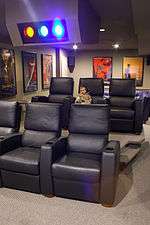CRT projector
A CRT projector is a video projector that uses a small, high-brightness cathode ray tube as the image generating element. The image is then focused and enlarged onto a screen using a lens kept in front of the CRT face. The first color CRT projectors came out in the early 1950s. Most modern CRT projectors are color and have three separate CRTs (instead of a single, color CRT), and their own lenses to achieve color images. The red, green and blue portions of the incoming video signal are processed and sent to the respective CRTs whose images are focused by their lenses to achieve the overall picture on the screen. Various designs have made it to production, including the "direct" CRT-lens design, and the Schmidt-CRT, which employed a phosphor screen that illuminates a perforated spherical mirror, all within an evacuated "tube."

The image in the Sinclair Microvision "flat" CRT is viewed from the same side of the phosphor struck by the electron beam. The other side of the screen can be connected directly to a heat sink, allowing the projector to run at much brighter power levels than the more common CRT arrangement.[1]
Though systems utilizing projected video at one time almost exclusively used CRT projectors, they have largely been replaced by other technologies such as LCD projection and Digital Light Processing. Improvements in these digital video projectors, and their subsequent increased availability and desirability, resulted in a drastic decline of CRT projector sales by the late 2000s. As of 2012, very few (if any) new units are manufactured, though a number of installers do sell refurbished units, generally higher-end 8" and 9" models .
Advantages and disadvantages
Advantages
- Long service life; CRT's maintain good brightness to 10,000 hours.[2]
- High-end CRT projectors can precisely display images up to 1920 x 1200 [3][4] with accurate color reproduction. A few projectors can scan at even higher resolutions up to 3200 x 2560, although their ability to resolve fine detail at this resolution is greatly reduced.
- Superior black level compared to LCD and DLP based projectors .
- As with CRT monitors, the image resolution and the refresh rate are not fixed but variable within some limits. Interlaced material can be played directly, without need for imperfect deinterlacing mechanisms .
- Very fast response time (especially when compared to LCD-based projectors), resulting in minimal (if any) motion blur when showing video with fast motion .
- CRT projectors do not show a rainbow effect seen with single chip DLP projectors .
Disadvantages
- CRT projectors are both considerably larger and heavier than comparable LCD and DLP projectors.[5]
- CRT projectors require far more time to set up and adjust than LCD and DLP based projectors.
- Absolute ANSI brightness achievable with CRT projectors is lower than with comparable lamp-powered LCD and DLP projectors.
- Low-end or poorly tuned CRT projectors may suffer from color divergence or geometric distortion (for example, straight lines may not always appear completely straight, especially near the corners).
- CRT projectors use more power / cost more to run than LCD and DLP units.
- Unlike LCD or DLP projectors, CRT projectors are somewhat prone to burn-in. This can lead to issues in brightness uniformity on projectors that frequently use both a full 4:3 and widescreen aspect ratio.
See also
References
http://www.eisemann-theater.com/#/crt-projectors/
http://www.eisemann-theater.com
- "Innovation in electronics" by Alan Burkitt "Electronics Servicing & Technology" magazine 1982 July
- Barco Cine 9, Sony G90
- The Barco 912 claims an addressable resolution of 3200 x 2560 but with a bandwidth of 180 MHz it is unable to resolve this resolution with any clarity. "Barco 912". barco.com. Archived from the original on 2005-03-21. Retrieved 2008-02-01.
- The Sony G70 weighs 83 kg and measures 0.36 x 0.7 x 0.95 m whereas the LCD based projector weighs 3.6 kg and measures 0.09 x 0.34 x 0.26 m